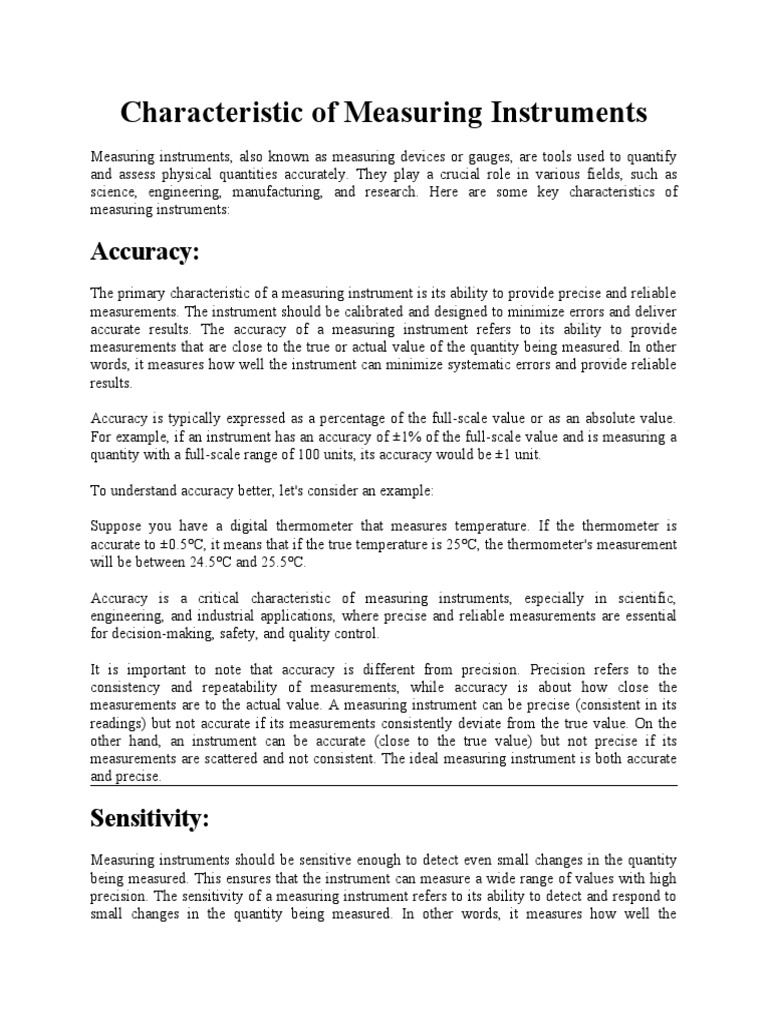Measuring instruments lie at the heart of empirical science, acting as the conduits through which we ascertain the physical properties of the world around us. Their significance is profound, as they unravel the mysteries of the universe by converting intangible phenomena into quantifiable data. The following examination delineates the fundamental measuring instruments prevalent in various fields of scientific endeavor, elucidating their principles of operation and applications.
At the forefront of these instruments is the **ruler**, a quintessential device employed to gauge length. Typically fabricated from wood, plastic, or metal, rulers vary in scale and precision. Their primary function is to measure linear distances, yet the humble ruler serves a more profound role. It instills a sense of proportion and accuracy, qualities that resonate deeply within the scientific method. Its simplicity belies its importance; it is the instrument that initiates countless geometric explorations and serves as a foundation for spatial reasoning.
Next in line is the **caliper**, an instrument designed to measure internal and external dimensions with great precision. Calipers come in several varieties, including vernier, dial, and digital calipers. Their operation hinges on a pair of jaws that can be adjusted to grasp an object. The ability to achieve measurements with readings often down to fractions of a millimeter is not merely a feat of engineering; it reflects a deep-rooted human pursuit of precision. In mechanical engineering and manufacturing, calipers provide the critical data needed for the fabrication of components, where even the slightest deviation can result in failure.
We turn our attention now to the **balance**, a quintessential instrument for determining mass. While the modern electronic balance utilizes electromagnetic force restoration, the principle of the balance traces back to the ancient beam balance. The equilibrium achieved when weights are placed on either side of the beam speaks to a fundamental concept in physics: that of balance and equilibrium in nature itself. In laboratories, the accuracy of mass measurements is integral to the molar calculations in chemical reactions and the characterization of material properties.
The **thermometer** emerges as another pivotal instrument in the arsenal of measurement tools. Thermometers quantify temperature changes, providing critical data across innumerable fields – from meteorology to medicine. They operate on principles of thermal expansion or changes in electrical resistance. The fascination with heat transfer and its impact on physical states emphasizes humanity’s quest to understand thermodynamics – a realm where energy and matter interplay. The inaccurate readings could lead not just to misunderstandings in scientific experimentation but, historically, fatal errors in the medical field.
Moving to fluid dynamics, the **barometer** is instrumental in measuring atmospheric pressure. An indispensable tool for meteorologists, it also plays a crucial role in understanding weather patterns and predicting changes. Barometers operate on the principle that changes in atmospheric pressure can determine altitude and weather phenomena. The surge in popularity of barometric pressure observation throughout history illustrates humanity’s ongoing battle against the whims of nature, demonstrating an intrinsic desire to predict, control, and thrive amidst uncertainty.
Analogous to the barometer, the **anemometer** measures wind speed. In its simplest form, this device consists of rotating cups or blades that respond to wind currents. The dynamic nature of wind raises compelling discussions about energy transfer, ecology, and climate science. By quantifying this natural force, anemometers not only serve meteorologists but also critical applications in aviation and renewable energy fields, particularly in wind turbine optimization. The relationship between wind and energy generation is a testament to mankind’s increasing reliance on sustainable practices, highlighting a shift towards eco-conscious methodologies.
Equally noteworthy is the **multimeter**, an essential instrument for electrical measurements, encompassing the measurement of voltage, current, and resistance. Multimeters, particularly digital varieties, facilitate the troubleshooting of electrical circuits, lending critical insights into the functionality of intricate systems. The ability to combine multiple measurements into one device underscores the complexity of modern technology, allowing engineers and technicians to navigate the diverse landscape of electronic devices. The multimeter embodies the synergy between simplicity and complexity, a theme that resonates profoundly in technology and electronic engineering.
Lastly, the **oscilloscope** allows the visualization of electrical waveforms, providing a graphical representation of voltage against time. This instrument reveals the intricate dynamics of electrical signals, enabling scientists and engineers to delve deeply into the behavior of electrical circuits. Observing these waveforms grants a distinct understanding of periodicity and transient phenomena, facilitating advancements in electronics and telecommunications. The oscilloscope illustrates the seamless transition from abstract theory to tangible reality, bridging the realms of electrical engineering and practical application.
In conclusion, the realm of measuring instruments embodies the intricate connection between humanity’s curiosity about the universe and the technological advancements that spring from that curiosity. Each instrument, from the ruler to the oscilloscope, unveils layers of knowledge and facilitates the exploration of various scientific principles. It is through these tools that we embark on a quest for understanding, driven by an insatiable urge to quantify, qualify, and connect the abstract to reality. Measuring instruments are more than just tools; they are the very fabric that weaves together the narrative of scientific inquiry and discovery.










